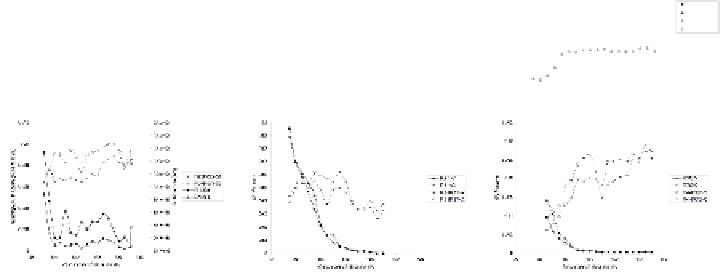Information Technology Reference
In-Depth Information
0.08
5.0E-04
0.6
0.06
0.18
4.5E-04
0.16
0.07
0.5
0.05
4.0E-04
0.14
0.06
3.5E-04
0.4
0.04
0.12
0.05
R58-V
R58-C
R41R79-V
R41R79-C
3.0E-04
R6R21-V
R6R21-C
R20-V
R20-C
R50-V
R50-C
R10R32-V
R10R32-C
0.1
0.04
2.5E-04
0.3
0.03
0.08
2.0E-04
0.03
0.2
0.02
0.06
1.5E-04
0.02
1.0E-04
0.04
0.1
0.01
0.01
5.0E-05
0.02
0
0.0E+00
0
0
0
80
100
120
140
160
180
80
100
120
140
160
180
80
100
120
140
160
180
a) number of documents
b) number of documents
c) number of documents
Fig. 5.
Negating the third topic of interest: a)
p.
1b)
p.
2c)
p.
3d)
p.
4e)
p.
5f)
p.
6
According to figure 3, learning a new, emerging topic of interest can also be
handled. In all cases the score of the new topic (bold line) shows an overall
increase. In addition to symmetric short-scale fluctuations between the scores
of the new and existing topics, we observe in many cases an overall drop in the
average score of the existing topics. Like before, this is partially due to the fixed
number of evaluation documents. Nevertheless, with the exception of task
n.
2,
the profile represents all three topics at the end of the adaptation phase.
The results for the third task are equally promising (fig. 4). Nootropia seems
able to forget a no longer interesting topic. In all cases, there is an overall drop in
the AUP score of the topic that no longer receives positive feedback (bold line).
It is usually followed by an increase in the score of the remaining two topics
for reasons already explained. However, only in tasks
f.
3and
f.
6 is the waning
topic completely forgotten. In the rest of the cases a longer adaptation period
might be necessary. When, on the other hand, the no longer interesting topics
explicitly receive negative feedback, we observe a larger overall decrease in their
score (fig. 5). This is clear in all cases. Now only in tasks
p.
1and
p.
4isn'tthe
no longer interesting topic completely forgotten.
Finally, the comparison between the full version (C) and its baseline version
(V), where links between terms are ignored, produced interesting results. For
most tasks C outperforms V. This finding demonstrates the importance of links
not only for representing multiple topics
8
, but also when adapting to changes in
them. It highlights the significance of the network structure and of the additional
information that it encodes, in defining and preserving the user's interests. There
are however, inconsistencies in the performance of C over V. For example, the
fourth combination of topics (R1/R29/R68) did not produce positive results
in any of the tasks (graph
d
in figures 2, 3, 4 and 5). This inconsistency in
performance prompts us for further improvements in the model, like maintaining
only links with large weights and calibrating term and link weights.
8
As it is also argued in [4].

































































































